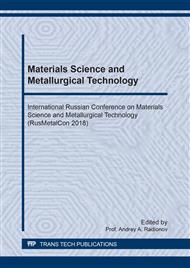[1]
V.F. Gubanova, S.V. Shishkina, E.A. Chudinova, A new method of combined finishing-strengthening processing, Forging-stamping production, Materials pressure treatment, 1 (2014) 27-29.
Google Scholar
[2]
V.I. Malysheva, A.S. Selivanova, Dislocation density analysis of the relationship with the plastic deformation of the surface layer at the conventional ultrasonic diamond burnishing, Vector of science TSU, 6 (2009) 7-11.
Google Scholar
[3]
I.N. Bobrovsky, P.A. Melnikova, Parts machining technology by the surface plastic deformation without the use of lubricating and cooling technical means, Samara scientific centre of the Russian Academy of Sciences, (2012).
Google Scholar
[4]
P.S. Kamble, P.S. Kamble, V.S. Jadhav, Experimental study of roller burnishing process on plain carrier of planetary type gear box, Maharashtra, India, (2012).
Google Scholar
[5]
A.P. Ghodake, A.P. Ghodake, R.D. Rakhade, A.S. Maheshwari, Effect of burnishing process on behavior of engineering materials, Nasik, India, (2013).
Google Scholar
[6]
U.D. Gulhane, S.B. Mishra, P.K. Mishra, Enhancement of surface roughness of 316 L stainless steel and Ti-6Al-4V using low plasticity burnishing, Allahabad, India, (2011).
Google Scholar
[7]
M.V. Kharchenko, R.R. Dema, M.V. Kharchenko, A.A. Gorbunova, Theoretical study of the lubrication intervals effect on energy consumption change in hot rolling at the rolling mill 2000 at OJSC MMK,, Production of steel, 2 (2013) 11-13.
Google Scholar
[8]
R.R. Dema, R.N. Amirov, S.I. Platov, I.V. Kazakov, Mathematical modeling of the working rolls wear in the quarto stand when applying a lubricant, Ferrous metals, 6 (2012) 54.
Google Scholar
[9]
M.V. Kharchenko, I.S. Pelymskaya, Evaluating the effectiveness of the finishing hot rolling process using a lubrication supply system, Ferrous metallurgy, 11 (2013) 46-50.
Google Scholar
[10]
R.N. Amirov, R.R. Dema, S.I. Platov, U.D. Martynov, K.K. Akhmetov, Research and evaluation of the main drives workload on the continuous stand group at the hot rolling mill 2000, depending on product mix, Production of steel, 2 (2014) 13-16.
Google Scholar
[11]
M.V. Kharchenko, R.R. Dema, A.V. Jaroslavtsev, The development of lubrication technology on the back-up rolls for the production of high-strength steels in hot rolling, Urgent problems of contemporary science, technology and education, collection of scientific papers, Nosov Magnitogorsk state tehn. Univ., Magnitogorsk, 1(1) (2010) 307-310.
Google Scholar
[12]
I.V., Kragel'skij, V.V. Alisina, Friction, wear and lubrication, Reference book, in 2 books, ed., Moscow, Mechanical Engineering, Book 1, 1978, 46-57.
Google Scholar
[13]
I.V. Kragel'skij, Friction and wear, I.V. Kragel'skij, ed. 2-revised and added, Moscow, Mechanical Engineering, (1968).
Google Scholar
[14]
I.V. Kragel'skij, Calculation of friction, wear and durability from the standpoint of molecular-mechanical, fatigue and energy theories, Problems of automation and engineering, Moscow-Budapest, 12 (1986) 13-24.
Google Scholar
[15]
Yu.V. Zhirkin, Reliability and maintenance of metallurgical machines: Manual, Magnitogorsk, MGTU, (2005).
Google Scholar
[16]
A.P. Grudev, External friction during rolling, Moscow, Metallurgy, (1973).
Google Scholar
[17]
G. Kneppe, D. Rozenthal, Hot strip rolling technology, Tasks for the new century, MPT International, 22(3) (1998) 56-58, 60, 62, 64, 66, 67.
Google Scholar
[18]
D.T. Gaevik, Equipment lubrication for steelworks, Manual for SVS (secondary vocational schools), Moscow, (1998).
Google Scholar
[19]
D. S. Kodnir, E.P. Zhilnikov, Yu.I. Bajborodov, Eastohydrodynamic machine parts calculation, Moscow, Mechanical engineering, (1988).
Google Scholar
[20]
S.V. Dubovsky, R.R. Dema, M.V. Kharchenko, A.V. Yaroslavtsev, Integrated assessment and study of the application effectiveness of the lubricant supply to the backup rolls on the stands no. 7-9 of the hot rolling mill 2000 at the Magnitogorsk iron and steel works,, Production of rolled stock, 12 (2011) 6-8.
Google Scholar


